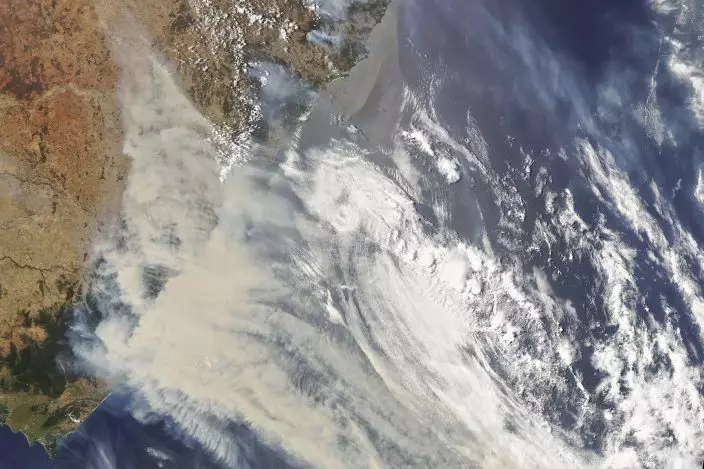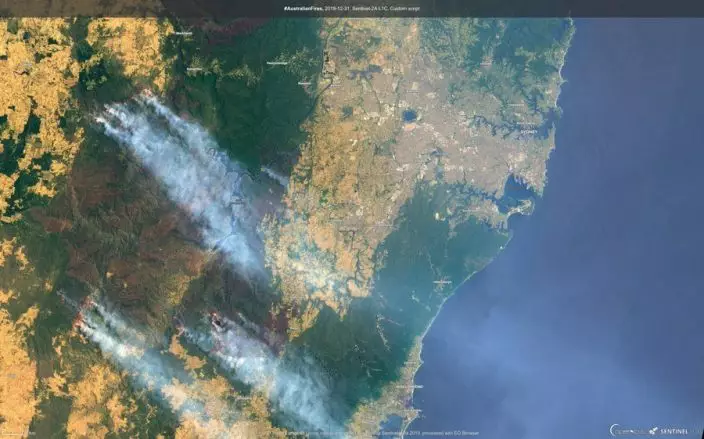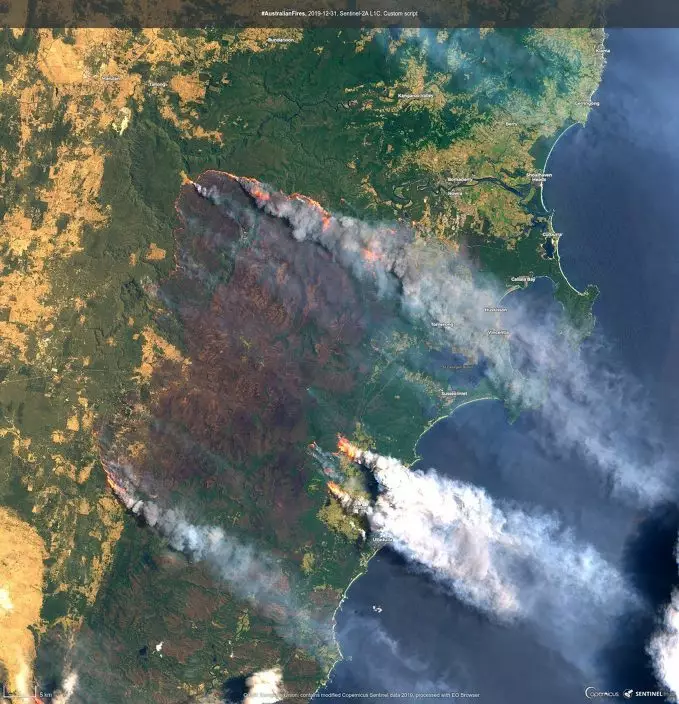Navy ships plucked hundreds of people from beaches and tens of thousands were urged to flee Friday before hot weather and strong winds in the forecast worsen Australia's already-devastating wildfires.
More than 200 fires were burning, and warnings of extreme danger to come Saturday set in motion one of the largest evacuations in Australian history. Thousands have already fled at-risk coastal areas, creating traffic gridlock in places, and firefighters escorted convoys of evacuees as fires threatened to close roads.
Victoria Premier Daniel Andrew declared a disaster across much of the eastern part of the state, allowing the government to order evacuations in an area with as many as 140,000 permanent residents and tens of thousands more vacationers.

This Jan 1, 2020, photo captured by NASA's Aqua satellite and made available by the Moderate Resolution Imaging Spectroradiometer (MODIS) on NASA's Aqua satellite, shows thick smoke blanketing southeastern Australia along the border of Victoria and New South Wales. More than 200 fires are burning in Australia's two most-populous states. Blazes have also been burning in Western Australia, South Australia and Tasmania. (NASA via AP)
"If you can leave, you must leave," Andrews said.
South Australia state's Country Fire Service chief officer Mark Jones said the weather conditions were cause for concern because some fires were still burning or smoldering.
"The ignition sources are already there," he said. "There are millions of sparks out there ready to go if they break containment lines."

In this satellite image released by Copernicus Sentinel Imagery, 2020 twitter page dated Dec. 31, 2019, fires burning around Sydney, Australia. (Copernicus Sentinel Imagery via AP)
The early and devastating start to Australia’s summer wildfires has made this season the worst on record. About 5 million hectares (12.35 million acres) of land have burned, at least 19 people have been killed, and more than 1,400 homes have been destroyed.
This week, at least 448 homes have been destroyed on the New South Wales southern coast and dozens were burned in Victoria. Ten deaths have been confirmed in the two states this week, and Victoria authorities also say 28 people are missing. Fires are also burning in Western Australia, South Australia and Tasmania.
The navy was evacuating hundreds from the Victorian coastal town of Mallacoota, which has been cut off for days by wildfires, forcing as many as 4,000 residents and tourists to shelter on beaches. Landing craft ferried people to the HMAS Choules offshore.

In this satellite image released by Copernicus Sentinel Imagery, 2020 twitter page acquired Dec. 31, 2019, shows the Clyde Mountain Fire, 200 kms. (124 miles) south of Sydney, Australia. (Copernicus Sentinel Imagery via AP)
Choules Commander Scott Houlihan said 963 people had signed up for evacuation by sea and more had been airlifted to safety.
A state of emergency was in place in New South Wales and a total fire ban.
State Rural Fire Service deputy commissioner Rob Rogers said strong winds and high temperatures Saturday will make the fire danger worse in many areas and urged those who can flee to do so.

In this Monday, Dec. 30, 2019, aerial photo, acres of scorched land are seen in Bairnsdale, Australia. Thousands of tourists fled Australia's wildfire-ravaged eastern coast Thursday ahead of worsening conditions as the military started to evacuate people trapped on the shore further south. (Glen Morey via AP)
"We know people have got a little bit of fire fatigue. They've been dealing with this now for months," Rogers said. “But we need people to stay focused. Tomorrow is not the day to drop your guard. Take it seriously. If you're in those areas where we put those maps out, do not be there.”
Prime Minister Scott Morrison visited the township of Bairnsdale in Victoria and received a warmer welcome than a day earlier in New South Wales.
Morrison cut short a visit to the town of Cobargo when locals yelled at him, made obscene gestures and called him an “idiot” and worse, criticizing him for the lack of equipment to deal with the fires in town.
In a radio interview Friday, Morrison said he understood the anger of people affected by the fires.
"People are angry and people are raw and people are upset," he said. "Whether they are angry with me or they are angry about the situation, all I know is they are hurting and it's my job to be there to try and offer some comfort and support."
Smoke from the wildfires has choked air quality and turned daytime skies to near-nighttime darkness in the worst-hit areas.
It's also blown across the Tasman Sea into New Zealand, where skies are hazy and glaciers have turned a deep caramel brown. The color change may cause more melting since the glaciers will reflect less sunlight.


